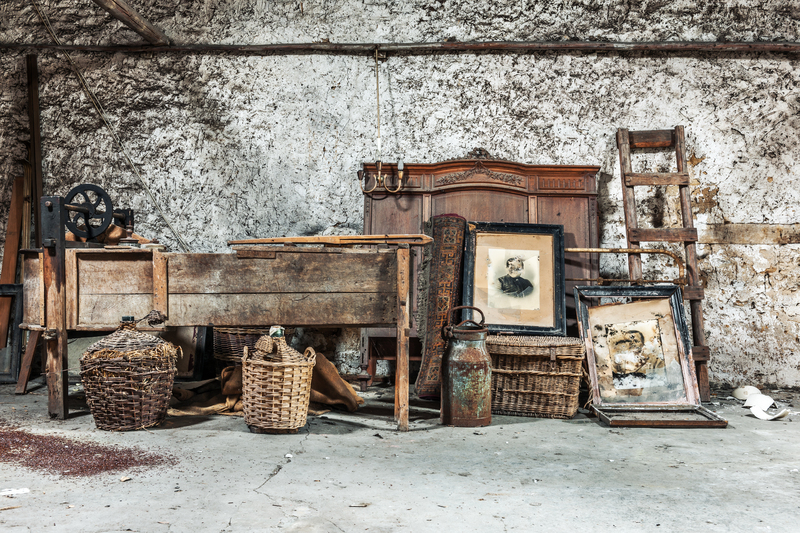Protect Your Sofa: Tips for Safe Long-Term Storage
Posted on 01/06/2025
Protect Your Sofa: Tips for Safe Long-Term Storage
Storing a sofa can be challenging, especially if you want to preserve its beauty and integrity for years to come. Whether you're relocating, undergoing home renovations, or simply saving furniture for future use, proper storage is imperative. This comprehensive guide reveals the best strategies and expert tips to protect your sofa in storage and ensure it stays in top condition. You'll find everything you need to know about sofa protection, from preparation and packing to choosing the right storage unit and post-storage care.
Why Proper Sofa Storage Matters
Your sofa is one of your home's most-used pieces of furniture and can be a significant investment. Poor storage can result in:
- Mold and mildew growth due to moisture exposure
- Fabric discoloration from sunlight or humidity
- Structural damage from poor handling or placement
- Unpleasant odors or pest infestations

Step 1: Clean and Prepare Your Sofa for Storage
Thorough Cleaning
Before anything else, make sure your sofa is spotless. Dirt, crumbs, or stains can become permanent and attract pests. Here's how to prepare your sofa:
- Vacuum every corner, including under cushions and along seams.
- Spot clean stains using recommended products for your sofa material.
- Allow the sofa to dry completely before moving to avoid mold and mildew.
Disassemble If Possible
If your couch can be disassembled, do so. Remove legs, detachable arms, and cushions. This not only makes the sofa easier to move but helps prevent structural damage during long-term sofa storage.
- Keep all small parts in a labeled plastic bag and tape it to the sofa frame.
- Wrap disassembled pieces separately for extra protection.
Step 2: Pack and Wrap Your Sofa Properly
Select the Right Protective Materials
Proper packing is crucial to protect your couch in storage. Invest in high-quality supplies:
- Furniture blankets
- Plastic wrap or shrink wrap
- Bubble wrap for fragile parts
- Breathable covers (cotton or canvas)
Important: Never wrap your entire sofa in plastic for extended periods. It may trap moisture and cause mold. Instead, use plastic only for the outside, then add a permeable cover.
Wrap Cushions and Fragile Areas
Wrap all removable cushions in breathable fabric covers. For delicate wood or metal elements, use bubble wrap and blankets to shield from dents or scratches.
Protect Sofa Legs and Corners
Pay special attention to legs and corners, which are most susceptible to knocks. Cover them with extra padding or cardboard protectors.
Step 3: Choose the Best Storage Solution
Climate-Controlled Storage Units
When it comes to safe long-term sofa storage, climate control is your best friend. Fluctuations in temperature and humidity can:
- Warp wood frames
- Promote mold and mildew growth
- Fade and deteriorate upholstery
Unit Size and Preparation
Make sure the storage unit is large enough to accommodate your sofa without bending or stacking. Overcrowding puts pressure on cushions and frames, leading to permanent damage.
- Store the sofa in an upright position if possible
- Leave space around it for air circulation
- Lay a tarp, wooden pallet, or plastic sheeting on the floor to minimize moisture transfer
Secure the Storage Space
Enhance sofa protection in storage by choosing a facility with robust security features--such as gated access, surveillance cameras, and individual unit locks.
Step 4: Move and Position Your Sofa Correctly
Safe Transportation
Transporting your sofa requires a gentle touch:
- Lift from the sturdiest points (usually the frame) to avoid tearing the upholstery or damaging joints
- Secure the sofa in the moving vehicle to prevent shifting during transit
- Use blankets to protect against bumps and scrapes
Optimal Placement in Storage
Once inside the unit, avoid placing the sofa directly against walls. Leaving at least 4-6 inches of space helps air flow and minimizes risk from condensation or leakage.
- Never stack heavy items on top of your sofa, as this can cause permanent dents and warping.
- Position the sofa away from any possible leaks or windows that could let in heat and light.
Step 5: Protect Against Pests
Nothing ruins a beautiful sofa faster than pests like rodents or insects. Here's how to safeguard:
- Store only perfectly clean, dry furniture to avoid attracting pests
- Add natural repellents such as lavender sachets or cedar blocks
- Inspect your storage unit regularly for signs of infestation
- Never store food or perishables in your unit
Step 6: Long-Term Storage Maintenance
Regular Checks
Even when stored, your sofa benefits from periodic checks:
- Open the unit every few months to air out your sofa
- Check for moisture, odor, or signs of pests
- Replace bedding or breathable covers if they seem damp or stained
Refreshing Your Sofa After Storage
When it's time to bring your sofa back home, follow these steps:
- Remove all covers and padding
- Vacuum the sofa thoroughly
- If needed, spot clean areas and let them dry fully
- Let your sofa acclimatize to your home's environment before using it extensively
Materials Make a Difference: Upholstery-Specific Storage Tips
Leather Sofa Storage
Leather needs special care in storage:
- Condition the leather with a high-quality product before wrapping
- Avoid plastic--opt for breathable cotton sheets
- Keep away from heat sources to prevent drying and cracking
Fabric Sofa Storage
For fabric sofas:
- Ensure fabric is bone dry prior to wrapping
- Use fabric-friendly cleaners to prevent fading or residue
- Store in a cool, dry environment to prevent mildew
Wood-Trimmed Sofas
Protect wooden accents by:
- Covering them with padding and a breathable wrap
- Keeping out of direct sunlight to prevent fading
- Ensuring humidity stays stable to avoid warping
Common Mistakes to Avoid During Sofa Storage
Avoid these frequent errors to ensure your couch stays safe in storage:
- Storing while damp: Always allow the sofa to dry fully after cleaning
- Using non-breathable covers: Traps moisture and causes mildew
- Poor placement: Don't squish the sofa between other items
- Forgetting regular checks: Long-term neglect can allow damage to set in
- Improper pest prevention: Don't underestimate the risk of insects or rodents
Eco-Friendly Tips for Sofa Storage
Sustainable storage is growing in popularity. Here's how to protect your sofa during long-term storage while being eco-conscious:
- Use reusable furniture blankets and natural fabrics for wrapping
- Choose wood pallets instead of plastic sheets
- Select storage units with solar power or green certifications
- Re-purpose or recycle unwanted sofa parts and materials

Frequently Asked Questions About Sofa Storage
- How long can I safely store my couch?
With proper preparation and climate control, sofas can be securely stored for years. - Can I store my sofa in a garage or basement?
It's best to avoid these spaces due to temperature fluctuations and humidity, unless properly insulated and dehumidified. - What is the best material to use for covering sofas in storage?
Breathable cotton or canvas covers are excellent for long-term sofa storage. - How do I deodorize a stored sofa?
Baking soda, sunlight, or fabric-safe sprays can help freshen your couch after storage.
Conclusion: Keep Your Sofa Safe During Storage
Learning how to store your sofa safely for the long term is an investment in your furniture's future. By cleaning thoroughly, packing carefully, selecting the right storage space, and conducting regular maintenance checks, you can ensure your sofa emerges from storage looking and feeling as comfortable as ever.
Never underestimate the importance of small details--like using breathable covers or maintaining climate control--which make a big difference in sofa preservation. Follow these expert recommendations and enjoy peace of mind knowing your beloved couch is protected no matter how long it stays in storage.
For more furniture care tips and storage advice, explore our related resources and stay ahead of the curve in sofa protection and furniture storage best practices.

 request quote
request quote





